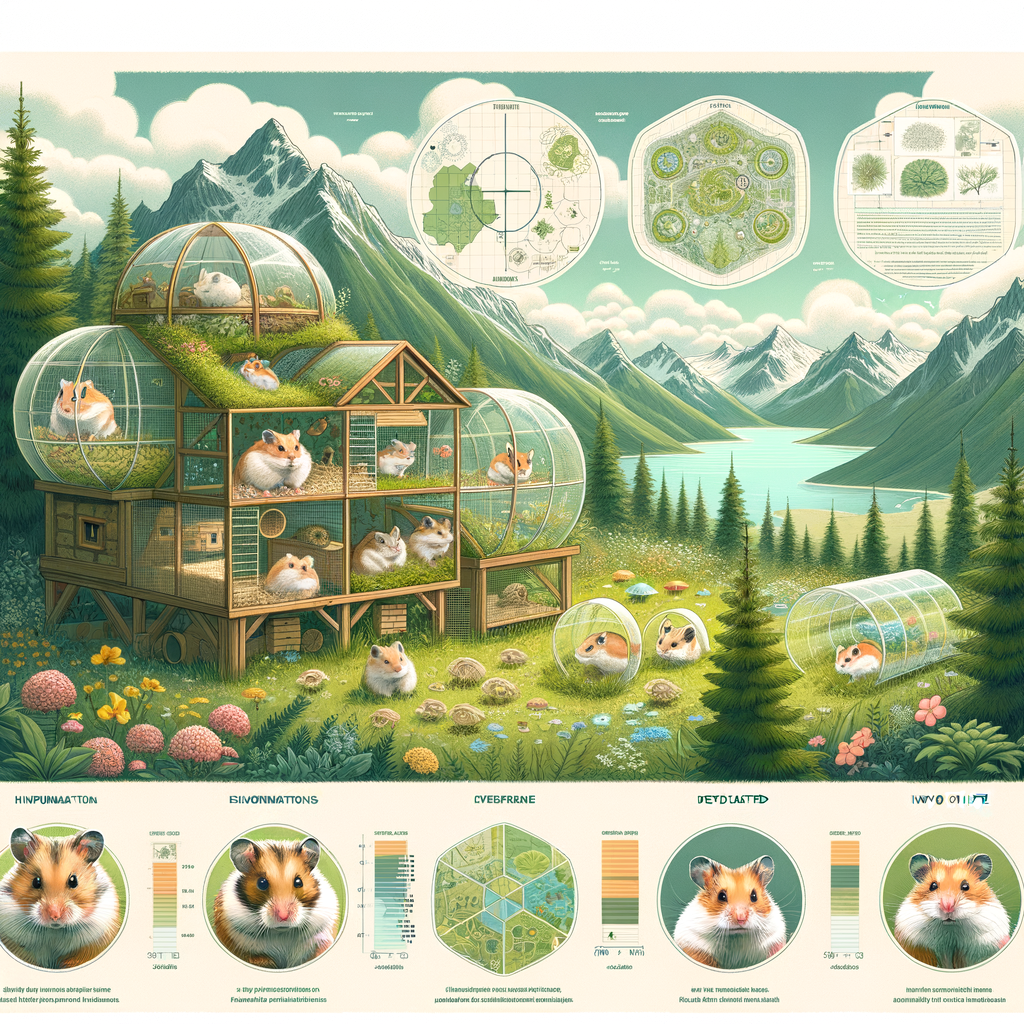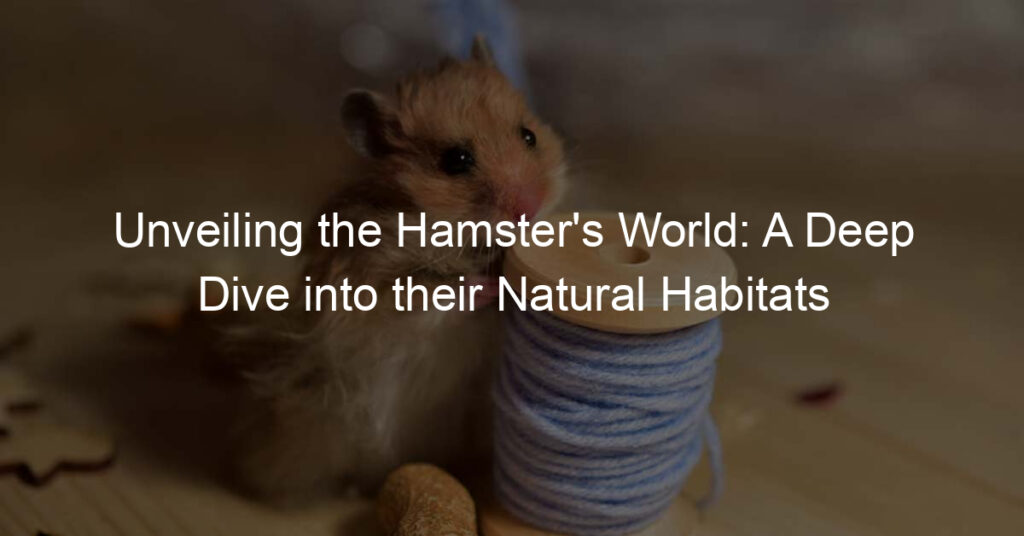
Introduction to Hamster Habitats
Hamsters are small, furry creatures that are often kept as pets. They are known for their playful nature and adorable looks. However, to ensure their happiness and health, it’s crucial to understand their natural habitats and lifestyle. This knowledge will help us create a comfortable and stimulating environment for them at home.
- Understanding the importance of natural environments for hamsters
- Overview of the hamster lifestyle in nature
Hamsters are originally from desert areas in the wild. They are accustomed to a certain type of environment that provides them with everything they need for survival. In their natural habitats, they have access to a variety of foods, plenty of exercise, and the ability to burrow, which is a key aspect of their lifestyle.
When we keep hamsters as pets, we need to replicate these conditions as closely as possible. This means providing them with a spacious cage, a balanced diet, and opportunities for physical activity. By doing so, we can ensure that our hamsters live a long, healthy, and happy life.
Hamsters are nocturnal creatures, which means they are most active during the night. In the wild, they spend their nights foraging for food and exploring their surroundings. They are solitary animals and prefer to live alone, each having its own territory.
Hamsters are also excellent burrowers. They dig complex tunnel systems in the wild, which they use for sleeping, storing food, and hiding from predators. These tunnels can be quite extensive, with multiple entrances and exits for quick escape.
Understanding the hamster’s natural lifestyle is essential when creating their habitat at home. We should provide them with a quiet, dark place to sleep during the day, plenty of food to forage, and materials for burrowing. This will help them exhibit their natural behaviors and lead a fulfilling life.
In the following sections, we will delve deeper into the specifics of creating a suitable habitat for your pet hamster, exploring various types of habitats, and investigating the best ways to mimic their natural environments. Stay tuned to unveil the fascinating world of hamsters!
Exploring Hamster Habitats
As we delve into the world of hamsters, it’s important to understand their natural habitats. This will help us appreciate their unique characteristics and needs. Let’s start by exploring the wild habitats of hamsters.
Wild Hamster Habitats
Wild hamsters are fascinating creatures that have adapted to survive in various environments. They have specific characteristics that make their habitats unique.
- Characteristics of Wild Hamster Habitats
- Types of Natural Habitats Where Hamsters Thrive
Wild hamster habitats are typically characterized by burrows. These burrows are complex tunnel systems that provide safety from predators and harsh weather conditions. They contain multiple chambers for different purposes such as sleeping, storing food, and even raising their young. The burrows maintain a constant temperature, providing a comfortable living environment for the hamsters.
Hamsters are found in a variety of natural habitats. Some common types include:
| Type of Habitat | Description |
|---|---|
| Deserts | Some hamsters, like the Syrian hamster, are native to desert regions. They are nocturnal to avoid the intense heat during the day. |
| Grasslands | Hamsters such as the Roborovski dwarf hamster thrive in grassland habitats. They use the grass for cover from predators. |
| Forest edges | Some hamsters prefer the edges of forests where they can find a variety of food sources. |
Understanding the natural habitats of hamsters helps us appreciate their adaptability and resilience. In the next section, we will look at how these wild habitats compare to the domestic environments in which many hamsters now live.
Domestic Hamster Habitats
When it comes to creating a home for your pet hamster, it’s crucial to understand the differences between their natural, wild habitats and the domestic environments we provide for them. Let’s delve into these differences and explore how we can make our domestic hamster habitats as comfortable and natural as possible.
- Comparison between wild and domestic hamster habitats
- How to mimic natural living conditions for domestic hamsters
Wild hamsters are accustomed to a variety of environments, from deserts to grasslands. They live in burrows, which offer protection from predators and harsh weather conditions. These burrows often have multiple entrances and chambers for storing food and nesting. On the other hand, domestic hamsters live in cages or enclosures, which are significantly smaller and lack the complexity of a burrow. However, with proper care and attention to detail, we can make these enclosures a suitable home for our furry friends.
Mimicking a hamster’s natural habitat in a domestic setting can be achieved through a few simple steps. Firstly, provide plenty of bedding for burrowing. Hamsters love to dig and hide, so a thick layer of safe, unscented paper-based bedding is ideal. Secondly, include a variety of toys and tunnels to simulate the complexity of a burrow. Lastly, ensure your hamster has a quiet and private area for nesting, just like they would in the wild.
Remember, every hamster is unique and may have different preferences. Observe your hamster’s behavior and adjust their habitat accordingly. By doing so, we can ensure our domestic hamsters live a happy and healthy life, as close to their natural living conditions as possible.
| Wild Hamster Habitats | Domestic Hamster Habitats |
|---|---|
| Deserts, grasslands | Cages, enclosures |
| Multiple entrances and chambers | Single entrance, limited space |
| Protection from predators and weather | Protection from household hazards |
Investigation of Hamster Environments
Let’s delve into the intriguing world of hamster habitats. We’ll explore the research methods used in studying these environments and discuss the key findings from these studies.
Study of Hamster Habitats
- Research methods used in studying hamster environments
Researchers employ a variety of methods to study hamster habitats. One common approach is direct observation, where scientists watch and record hamsters’ behavior in their natural environments. They take note of the types of food hamsters eat, their nesting habits, and their social interactions.
Another method is experimental manipulation. In this method, researchers change certain elements in the hamster’s environment and observe how the hamster reacts. For example, they might introduce new food sources or change the layout of the habitat to see how the hamster adapts.
- Key findings from studies on hamster natural habitats
Studies on hamster habitats have revealed fascinating insights. For instance, hamsters are found to be highly adaptable creatures. They can thrive in a variety of environments, from dry deserts to lush forests. Their diet is also quite varied, consisting of seeds, fruits, and even small insects.
Another key finding is that hamsters are solitary animals. They prefer to live alone in their burrows, which they dig themselves. These burrows can be quite complex, with multiple entrances and chambers for storing food and raising young.
Lastly, studies have shown that hamsters are nocturnal. They are most active at night, which is when they venture out of their burrows to forage for food.
These findings highlight the importance of providing hamsters with an environment that mimics their natural habitat as closely as possible. This includes providing a variety of food options, opportunities for burrowing, and a quiet, dark place for them to rest during the day.
Stay tuned for our next section where we will discuss case studies on the impact of environment on hamster behavior and their adaptation to different habitats.
Case Studies
- Case study 1: Impact of Environment on Hamster Behavior
- Case study 2: Hamster Adaptation to Different Habitats
Our first case study examines how the environment affects hamster behavior. Researchers observed a group of hamsters in different environments: a standard cage, an enriched cage, and a semi-natural environment. The hamsters in the enriched and semi-natural environments showed more active behaviors, such as running and burrowing, compared to those in the standard cage.
| Environment | Behavior |
|---|---|
| Standard Cage | Less Active |
| Enriched Cage | More Active |
| Semi-Natural Environment | Most Active |
This study highlights the importance of providing hamsters with an environment that mimics their natural habitat to promote healthy behaviors.
The second case study focuses on how hamsters adapt to different habitats. Researchers placed hamsters in various habitats, including desert, forest, and grassland environments. They found that hamsters were able to adapt to each environment by changing their behavior and diet.
| Habitat | Adaptation |
|---|---|
| Desert | Consumed more water and sought shade |
| Forest | Consumed more plant-based food and climbed trees |
| Grassland | Consumed more insects and burrowed underground |
This study demonstrates the adaptability of hamsters to different habitats, emphasizing their resilience and versatility.
Key Takeaways on Hamster Natural Living Conditions
As we conclude our exploration of hamster habitats, it’s important to reflect on the key insights we’ve gathered. Understanding the natural living conditions of hamsters is not just interesting, but also crucial for anyone who owns or plans to own these adorable creatures. Let’s delve into the main takeaways.
- Importance of Understanding Hamster Natural Habitats
- Implications of Research on Hamster Environments for Pet Owners
Hamsters, like all animals, have specific needs and preferences when it comes to their living conditions. In the wild, they inhabit a variety of environments, from deserts to grasslands. They are burrowers by nature, creating complex tunnel systems for shelter and protection. This natural behavior is something they carry with them, even in captivity. Therefore, understanding their natural habitats can help us create a more comfortable and stimulating environment for our pet hamsters.
Research has shown that hamsters thrive when their living conditions mimic their natural habitats. This means providing them with enough space to move around, materials to burrow into, and a variety of foods similar to what they would find in the wild. By doing so, we can ensure our hamsters live a happy, healthy, and fulfilling life. Furthermore, understanding their natural environments can help us better interpret their behaviors and meet their needs more effectively.
In conclusion, the more we understand about the natural living conditions of hamsters, the better we can cater to their needs as pets. This not only enhances their quality of life but also allows us to form a stronger bond with these fascinating creatures.
Conclusion: Unveiling the Hamster’s World
In this article, we have embarked on a fascinating journey into the world of hamsters. From their habitats to their lifestyle, we have explored every aspect of their existence. Let’s summarize our findings and share some final thoughts.
- Summary of the deep dive into hamster habitats
- Final thoughts on the hamster lifestyle in nature
Hamsters are versatile creatures that can adapt to a variety of environments. In the wild, they prefer dry areas like deserts, steppes, and edges of forests. They build complex burrows with multiple chambers for different purposes, such as storing food, sleeping, and raising their young. These burrows can be up to a meter deep, providing them with protection from predators and harsh weather conditions.
Hamsters lead a solitary lifestyle in nature, only coming together during the breeding season. They are mostly nocturnal, spending their days sleeping in their burrows and coming out at night to forage for food. Their diet mainly consists of seeds, fruits, vegetables, and occasionally insects. Despite their small size, hamsters are known for their industrious nature and ability to survive in harsh conditions.
In conclusion, the world of hamsters is a fascinating one, filled with adaptability, resilience, and a unique lifestyle. Understanding their natural habitat and lifestyle can help us provide better care for our pet hamsters, ensuring they live a happy and healthy life.








